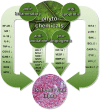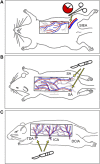Tissue-Protective Mechanisms of Bioactive Phytochemicals in Flap Surgery
- PMID: 35548348
- PMCID: PMC9081973
- DOI: 10.3389/fphar.2022.864351
Tissue-Protective Mechanisms of Bioactive Phytochemicals in Flap Surgery
Abstract
Despite careful preoperative planning, surgical flaps are prone to ischemic tissue damage and ischemia-reperfusion injury. The resulting wound breakdown and flap necrosis increase both treatment costs and patient morbidity. Hence, there is a need for strategies to promote flap survival and prevent ischemia-induced tissue damage. Phytochemicals, defined as non-essential, bioactive, and plant-derived molecules, are attractive candidates for perioperative treatment as they have little to no side effects and are well tolerated by most patients. Furthermore, they have been shown to exert beneficial combinations of pro-angiogenic, anti-inflammatory, anti-oxidant, and anti-apoptotic effects. This review provides an overview of bioactive phytochemicals that have been used to increase flap survival in preclinical animal models and discusses the underlying molecular and cellular mechanisms.
Keywords: flap; herbal medicine; ischemia–reperfusion injury; necrosis; nutraceuticals; phytochemicals.
Copyright © 2022 Weinzierl, Ampofo, Menger and Laschke.
Conflict of interest statement
The authors declare that the research was conducted in the absence of any commercial or financial relationships that could be construed as a potential conflict of interest.
Figures


Similar articles
-
Ischemic preconditioning improves the survival of skin and myocutaneous flaps in a rat model.Plast Reconstr Surg. 1998 Jul;102(1):140-50; discussion 151-2. doi: 10.1097/00006534-199807000-00022. Plast Reconstr Surg. 1998. PMID: 9655419
-
Extracorporeal shock wave treatment protects skin flaps against ischemia-reperfusion injury.Injury. 2012 Mar;43(3):374-80. doi: 10.1016/j.injury.2011.11.019. Epub 2011 Dec 18. Injury. 2012. PMID: 22186230
-
The Effect of Activated Protein C on Attenuation of Ischemia-Reperfusion Injury in a Rat Muscle Flap Model.Ann Plast Surg. 2015 Oct;75(4):448-54. doi: 10.1097/SAP.0000000000000118. Ann Plast Surg. 2015. PMID: 26360654
-
[Treatment of ischemia-reperfusion injury of flap].Zhongguo Xiu Fu Chong Jian Wai Ke Za Zhi. 2011 Mar;25(3):373-6. Zhongguo Xiu Fu Chong Jian Wai Ke Za Zhi. 2011. PMID: 21500597 Review. Chinese.
-
Remote ischemic preconditioning of flaps: a review.Microsurgery. 2005;25(4):346-52. doi: 10.1002/micr.20123. Microsurgery. 2005. PMID: 15880486 Review.
Cited by
-
Neuregulin-1, a member of the epidermal growth factor family, mitigates STING-mediated pyroptosis and necroptosis in ischaemic flaps.Burns Trauma. 2024 Jun 9;12:tkae035. doi: 10.1093/burnst/tkae035. eCollection 2024. Burns Trauma. 2024. PMID: 38855574 Free PMC article.
-
Research progress on quercetin in improving the survival rate of random skin flap.Arch Dermatol Res. 2025 Jan 16;317(1):267. doi: 10.1007/s00403-024-03696-5. Arch Dermatol Res. 2025. PMID: 39821658 Review.
-
Engineering stem cell exosomes promotes the survival of multi-territory perforator flap in diabetes via regulating anti-inflammatory and angiogenesis.Regen Biomater. 2025 Jul 24;12:rbaf075. doi: 10.1093/rb/rbaf075. eCollection 2025. Regen Biomater. 2025. PMID: 40837703 Free PMC article.
-
Global hotspots and future directions for drugs to improve the skin flap survival: A bibliometric and visualized review.J Pharm Anal. 2024 Jul;14(7):100948. doi: 10.1016/j.jpha.2024.02.002. Epub 2024 Feb 6. J Pharm Anal. 2024. PMID: 39109384 Free PMC article. Review.
-
An update on animal models of intervertebral disc degeneration and low back pain: Exploring the potential of artificial intelligence to improve research analysis and development of prospective therapeutics.JOR Spine. 2023 Jan 30;6(1):e1230. doi: 10.1002/jsp2.1230. eCollection 2023 Mar. JOR Spine. 2023. PMID: 36994457 Free PMC article. Review.
References
Publication types
LinkOut - more resources
Full Text Sources

